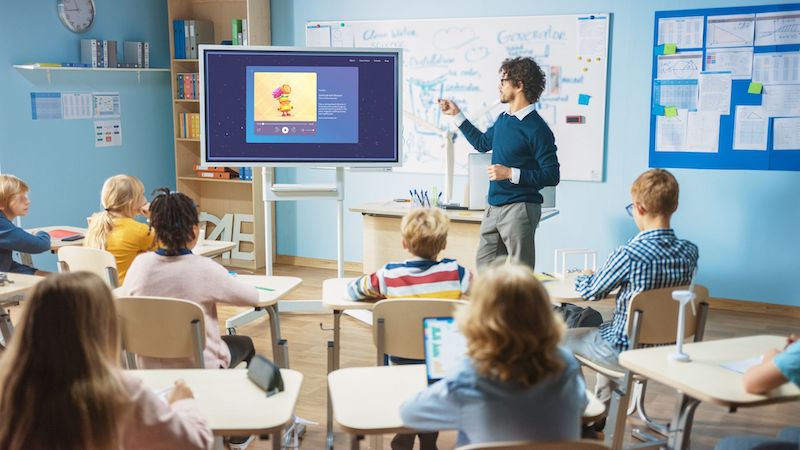
- 3 mins
5 Ways Moshi Can Help You Manage Your Classroom

Written by Drs. Chanda Murphy and Tegan Reeves, Moshi Researchers
Social and emotional learning (SEL) provides support for developing skills that encourage and lead to healthier and happier lives. That seems like a pretty big promise, right? Wel, it is. And for over thirty years researchers and educators have been working on an evidence base that helps support the claim.
As the central body for much of this work, the Collaborative for Academic, Social, and Emotional Learning (CASEL) provides a map of these skills in five dimensions: self-awareness, self-management, social awareness, relationship management, and decision making. Each of these dimensions could be explored separately (stay tuned!), but let’s start with a brief description of each. These are skills we work on at all ages but we will focus on examples of how these skills might show up in early childhood.
One of the first skills that SEL supports is the ability to notice what we are feeling. This noticing isn’t always easy, especially early in life, as it takes a connection in a more complex part of the brain. A fundamental way to support building self-awareness is to pause throughout our day in order to label our feelings. Once we build the awareness of our feelings we can start to notice how those feelings might impact our behavior.
In early childhood, self-awareness skills show up in emotion recognition and identity development. Noticing how we feel and creating labels for it creates pathways in the brain that help us soothe ourselves or motivate ourselves. Young children are also developing a sense of their own identity. Recognizing and naming what they like and don’t like can be a way to help build a healthy internal sense of autonomy and self.
When we build the ability to notice what impacts our actions, we are more able to make choices. Interestingly enough, during highly emotional moments the simple act of labeling our emotions (self-awareness) can help us calm down. But self-management is more than just calming down; it is also about responding to cues in our body that are healthiest for us. Things like eating when we are hungry and stopping when we are full are just as important for healthy development.
Self-management skills show up in early childhood more often than we might think. In fact, sometimes we inadvertently stop children from their own self-management strategies. For example, a child who has a great deal of energy may look like they are “out of control” when in reality they are managing their feelings by bouncing off the walls! Of course, wall-bouncing might not always be available so part of self-management is also sometimes about stopping ourselves.
Humans are built to be social. Noticing how others feel and how others make us feel is a key part of developing healthy and adaptive lives. Noticing how others might be feeling (or imagining how we might feel in certain situations) helps us understand our surroundings and puts us in a position to support and be supported. And noticing how other people make us feel is perhaps of equal importance.
This shows up strongly in early childhood as a natural part of development. As children develop, the impact of others becomes an increasingly influential component of brain chemistry. Similar to self-awareness, building language around the things children notice is really helpful. Practicing the skills of curiosity and compassion with children is a way to start developing social awareness. For example, when watching a television show we can talk about how characters may be feeling and/or how we would feel in their situation.
Whether it is a friend whom we can trust or a colleague with whom we collaborate, adult relationships are a fundamental component of our own wellness. We might not always think about how much time and effort it takes to foster these relationships in a positive way, but it takes a lot. And the skills to nurture and navigate these relationships develop in early childhood.
From imaginary friends to authority figures, young children often innately practice building relationships. Interaction is one obvious component of relationship management, but there are many more skills that are developed over time. With language and awareness, skills like empathy and boundary development can foster stronger and more meaningful relationships.
When we think about social and emotional skills we sometimes miss this crucial component of development. Interestingly, what is happening when we increase our awareness and management skills is that we also increase our ability to make clearly informed decisions. This is because the brain and body are influenced by the emotions that arise from our interactions with others and ourselves.
In early childhood, these decision-making skills can be developed through reflection as well as action. For example, something as simple as picking out a pair of shoes to buy—considering things like color, style, and comfort—can be a powerful way for a child to practice decision-making skills.
Now that you know a little bit more about the five dimensions of SEL, you can begin to plan how to teach and reinforce the necessary skills in the classroom and at home. Throughout the day, there are quick and easy ways, through language and actions, to model SEL. Whether you are driving in the car, waiting in line to go to a special, or working with a small group, SEL skills can be practiced.